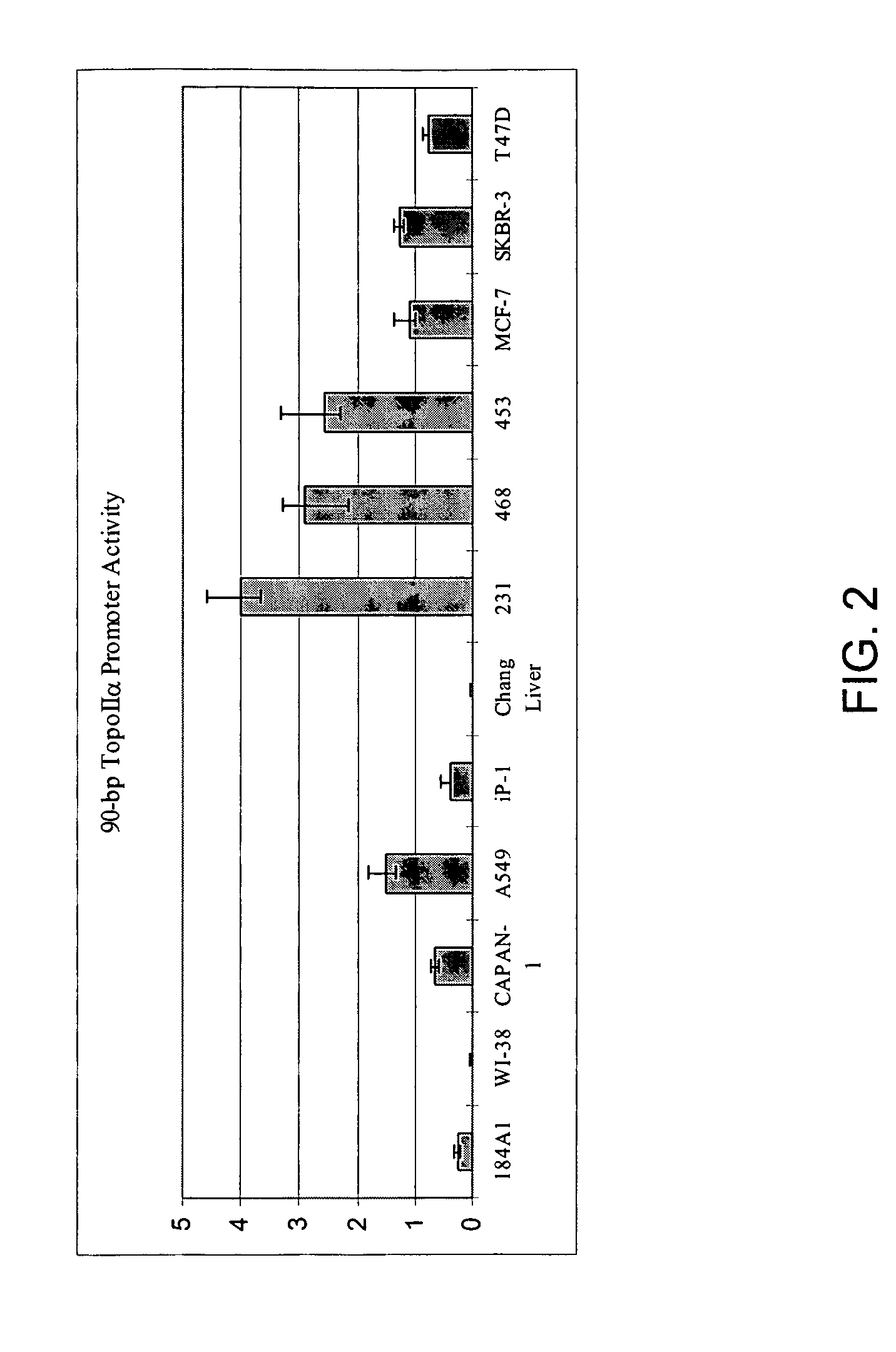Cancer specific promoters
a cancer and promoter technology, applied in the field of cancer biology, can solve the problems of low selectivity of tumor cells, side effects of normal tissues, and current breast cancer therapies, and achieve the effect of strong promoter activity
- Summary
- Abstract
- Description
- Claims
- Application Information
AI Technical Summary
Benefits of technology
Problems solved by technology
Method used
Image
Examples
example 1
Breast Cancer Tissue-Specific Expression
[0252] Current breast cancer (BC) therapies, such as chemotherapy (CT) and radiotherapy have low selectivity for tumor cells and side effects for normal tissues. To minimize the side effects, these therapies are generally given in an intermittent manner, allowing normal cells to recover between treatment cycles. However, during the recovery period, some surviving cancer cells become more resistant to the treatment because of gene mutation. Consequently, cancer recurrence or progression may occur. Tumor-targeting gene therapy can minimize treatment side effects and the risk of developing resistance by acting on the tumor-specific signaling pathways. In the present invention, breast cancer-specific promoters are used for breast cancer-targeting gene therapy of the exemplary therapeutic polynucleotide, mutant Bik.
[0253] The tumorigenesis and progression of breast cancer involve a series of genetic changes. The specifically activated genes in tu...
example 2
Pancreatic Cancer-Specific Expression
[0274] The present inventors utilized pancreatic cancer-specific promoter sequences to control expression of a polynucleotide encoding a mutant Bik polypeptide. Exemplary methods and compositions directed to this goal are described in this Example.
Cell Lines
[0275] Human pancreatic cancer (PANC-1, CAPAN-1 and AsPC-1), prostate cancer (LNCaP and PC-3) cell lines, immortalized normal lung fibroblast (WI-38) and mammary epithelial (184A1) cells were obtained from the American Type Culture Collection (ATCC, Rockville, Md.). Immortalized human pancreatic cells E6E7 was kindly provided by Dr. Paul Chiao (University of Texas M. D. Anderson Cancer Center, Houston, Tex.). Chang liver cells and ovarian cancer cell line SKOV3.ip1 were also used. PANC-1, CAPAN-1, AsPC-1, WI-38, and SKOV3.ip1, and Chang liver cells were cultured with DMEM / F12 medium supplemented with 10% fetal bovine serum (FBS), penicillin (100 units / ml) and streptomycin (100 mg / ml) (Invi...
example 3
Prostate Cancer-Specific Expression
[0294] The present inventors utilized prostate cancer-specific promoter sequences to control expression of a polynucleotide encoding a mutant Bik polypeptide. Exemplary methods and compositions directed to this goal are described in this Example.
Development of Targeted Gene Therapy for Metastatic and Recurrent Hormonal Refractory Prostate Cancer
[0295] In specific embodiments, a promoter that regulates expression of mutant Bik in both androgen-dependent and androgen-independent manners is utilized. A skilled artisan recognizes that in prostate cancer gene therapy, prostate specific promoters, like PSA (Greenberg, DeMayo et al., 1995; Spitzweg, Zhang et al., 1999; Latham, Searle et al., 2000; Wu, Matherly et al., 2001), probasin (Greenberg, DeMayo et al., 1995; Zhang, Thomas et al., 2000; Wen, Giri et al., 2003) and hK2 (Xie, Zhao et al., 2001) have been recently developed. The activities of these promoters are androgen-dependent. For patients wi...
PUM
| Property | Measurement | Unit |
|---|---|---|
| Time | aaaaa | aaaaa |
| Time | aaaaa | aaaaa |
| Time | aaaaa | aaaaa |
Abstract
Description
Claims
Application Information
 Login to View More
Login to View More - R&D
- Intellectual Property
- Life Sciences
- Materials
- Tech Scout
- Unparalleled Data Quality
- Higher Quality Content
- 60% Fewer Hallucinations
Browse by: Latest US Patents, China's latest patents, Technical Efficacy Thesaurus, Application Domain, Technology Topic, Popular Technical Reports.
© 2025 PatSnap. All rights reserved.Legal|Privacy policy|Modern Slavery Act Transparency Statement|Sitemap|About US| Contact US: help@patsnap.com



